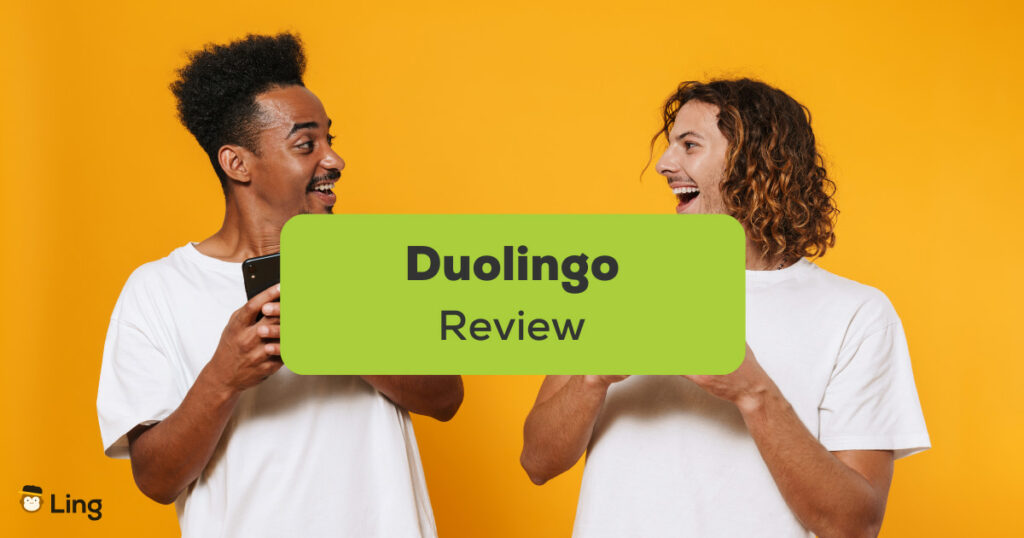Gamified apps are popular among younger audiences. But, will it be ample enough for learning a language? Take a look at our complete Duolingo review to see its edge against its competitors.
When it comes to learning, people have different pacings and styles. Some learn by attending physical language classes. Others, through free online resources. How do you decide which path you’ll take when studying your target language? Frequently, we want a mobile app with all the features needed to improve our language skills. But most of them cost a lot and may not even fulfill what we look for in language courses online.
Duolingo aims to make language learning fun with its fast and easy methods for people starting from scratch. But, what else can it offer than to learn vocabulary? Take a look at this detailed Duolingo review to see what it provides for grammar lessons and improving your weakest points.
Duolingo Overview
Duolingo is a straight-to-the-point gamified language app that is visually appealing and for beginners.
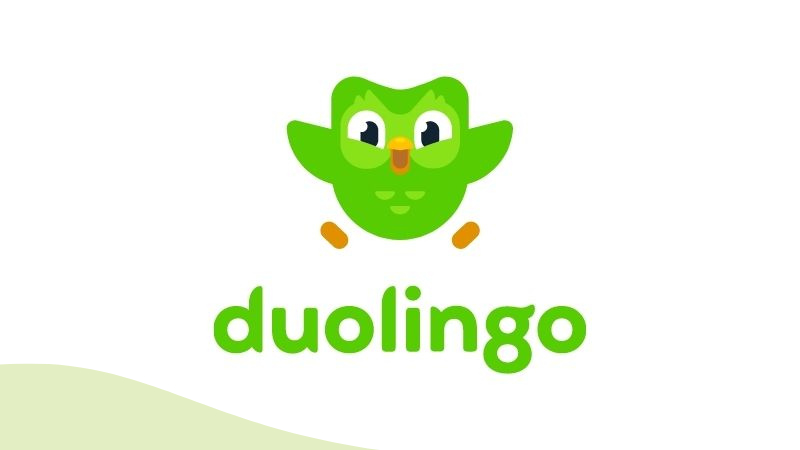
What Is Duolingo?
Do you remember flashcards for memorizing your multiplication table? It has the same concept that Duolingo has already mastered. Duolingo is a free app that is well known for making your dull, repetitive language lessons entertaining and something you would like to go back to again and again. Apart from that, it is an accessible and affordable platform for language learning.
What Is It for? A gamified flashcard-style language learning app with a helpful feature for memorizing vocabulary, phrases, and sentences.
Languages Offered: 38 languages.
Level: Beginner to Advanced.
Who Is It For?: Those who are learning a foreign language for the first time. It is for beginners who want gamified flashcards as a learning tool.
| Pros | Cons |
|---|---|
| Includes a placement test to determine your language level | Random vocabulary with no relationship to the sample sentences |
| Tracks your learning progress | Several languages are not accessible in Duolingo |
| All courses are available on the free version | Too much gamification gives a false sense of achievement |
| Mobile and easy to use | Lack of native speakers |
| Repeating words back to you after you select them | A few questions have missing or buggy words |
| Think through context clues | Lacks a separate feature for speaking exercises |
How Does Duolingo Work?
Visually appealing and targeted for quick vocabulary retention, Duolingo works as a game-focused language app. You can start learning immediately after signing up for a free Duolingo account. Then, you’ll go through the basic vocabulary and phrases and receive grammar lessons.
On the other hand, adaptive learning is in the premium edition called Duolingo Plus. It focuses on areas where students need to improve depending on their mistakes.
What languages can you learn on Duolingo? It has 38 languages, including fictional languages found in popular TV series like Game of Thrones (High Valyrian) and Star Trek (Klingon). You’ll also find Esperanto, the world’s most popular constructed international auxiliary language.
Here’s the complete list of languages you can learn in Duolingo:
| Spanish | Turkish | Hawaiian |
| French | Chinese | Hebrew |
| German | Japanese | Hindi |
| Italian | Korean | Irish |
| Portuguese | Vietnamese | Latin |
| Russian | Polish | Romanian |
| Danish | Swedish | Gaelic |
| Scottish | Greek | Welsh |
| Dutch | Arabic | Norwegian |
| Swahili | Czech | |
| Indonesian | Ukrainian |
Made-Up Languages:
- Esperanto
- Klingon
- High Valyrian
Currently Being Developed:
- Hungarian
- Navajo
- Yiddish
- Haitian Creole
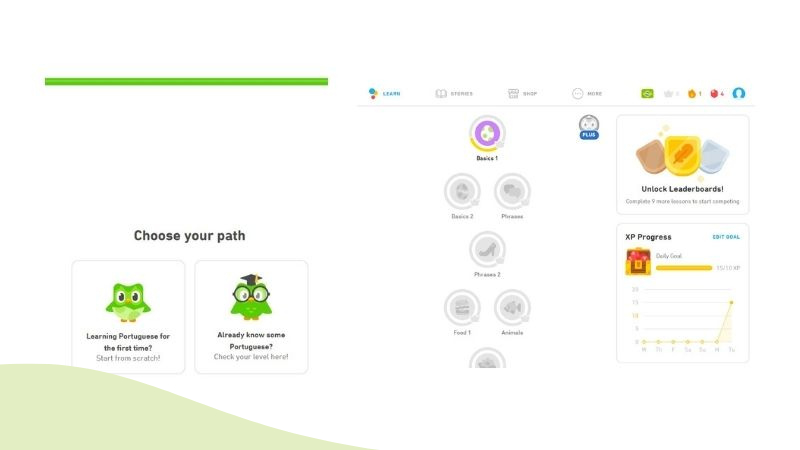
The Look And Feel Of Duolingo: Design And Interface
It’s not a surprise why Duolingo is one of the most downloaded education apps for learning new languages. While there are amazing apps like Pimsleur, Drops, Mango Languages, or Quizlet, Duolingo is still the most downloaded app. You’ll notice how younger users are the target with logos, fun animations, and a cute mascot that’s part of its logo. But, that also helps many adult learners feel that learning a language is fun and exciting, not boring and monotonous.
Duolingo has two platforms, one for the desktop and the other for their mobile app. There are only a few differences in their look and feel. We’ve listed their features so you can choose which platform you’ll get used to when you start learning.
Duolingo Desktop
The UI interface is straight to the point. The desktop interface has four tabs, including “Learn,” “Stories,” “Shop,” and “More.” You’ll also see which new language you are learning with your target language’s flag and the crown, streak, and lingots earned. At the center of the screen is the skill tree with vocabulary, phrases, quizzes, and specific grammar rules.
What I love about this setup is its simplistic approach to where you can browse your course material. It’s not difficult to navigate because all main content lessons are in one area.
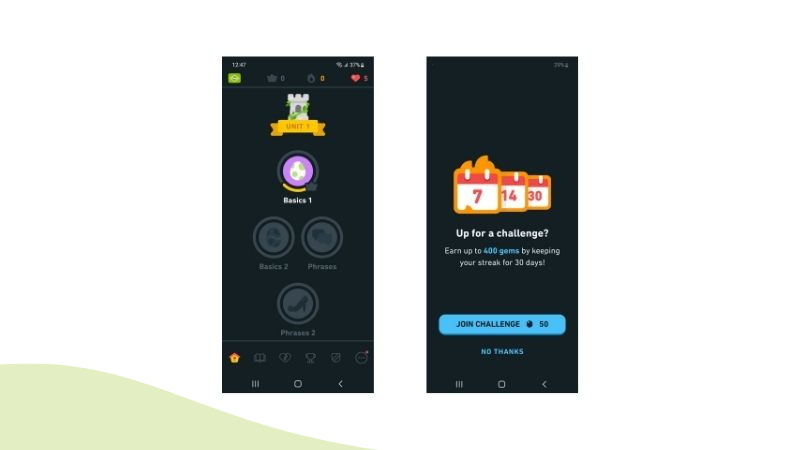
Duolingo App
There is not much difference in the look and design of the entire app compared to the desktop version. But, you’ll find many features of the language learning app to be more compact and suited for mobile phones. However, Dark Mode is only available for the Duolingo app. So, if you’re a Dark Mode enthusiast like me, you must use the app version instead.
Duolingo has six tabs for the app, which is similar to the desktop, but you’ll also see the “Challenges” tab and the ranking system of Duolingo.
The app is very responsive and easy to navigate as well. Since it’s convenient and concise, you can learn your Czech or Indonesian without having to press too many buttons.
Who Should Start Using Duolingo?
Is it your first time learning Polish as your new target language? You can try watching a YouTube video lesson to get familiar with pronunciations. Or, you can go directly to online teaching platforms to book a private tutor. We understand how it’s very confusing to choose among a large plate of options around the internet. Everyone seems like selling language courses like hot pancakes. But, we don’t blame them as languages open your mind to different cultures and people.
Duolingo is an excellent start for potential students who have zero knowledge of many languages around the world. If you love games, challenges, and a reward system, Duolingo offers these things and more. On the other hand, intermediate and advanced-level users who are already having trouble memorizing terms will benefit from Duolingo, too.
If you just want a speedy app that helps you recall words, then Duolingo is your best option.
Duolingo Features: What We Like About It
At a glance, you’ll already know that gaming is dominating the technology market. There are tons of apps for surveys, fun quizzes, surveys, fill-in questionnaires, and communicating with your friends.
Duolingo knows its audience and seeks to have various features that stand out from the rest of the other language learning apps. Take a look further at what Duolingo offers in the Pros and Cons section of this Duolingo review.
You Can Change Your Target Language Without Losing Your Progress
Want to become proficient in Chinese and German? You can switch back and forth between the lessons you’re taking. On top of that, you’ll not lose your streak or crowns per topic. You’ll be achieving the next few steps in becoming multilingual.
Includes Made Up Languages That You Can’t Find Organized Anywhere
Ever wanted to learn the way Targaryens speak? If you’re keen to say Valar Dohaeris to your friend daily, be glad to know that High Valyrian from Game of Thrones exists in Duolingo. I am quite surprised that there’s a resource like this online that is very extensive and well-researched. You’ll not see an entire course of High Valyrian anywhere else that’s educational other than Duolingo. There are also exclusive languages that you’ll see, like Klingon (Star Trek) and Esperanto.
Includes Placement Test To See Your Level
Are you returning from an online language course you’ve forgotten for quite some time? If you want to skip the basic grammar points and go straight away to more complex vocabulary and reading practice, you’ll be greeted with a placement test before you use the Duolingo app.
This feature is perfect for people who want to just brush up with vocabulary and grammar tips.
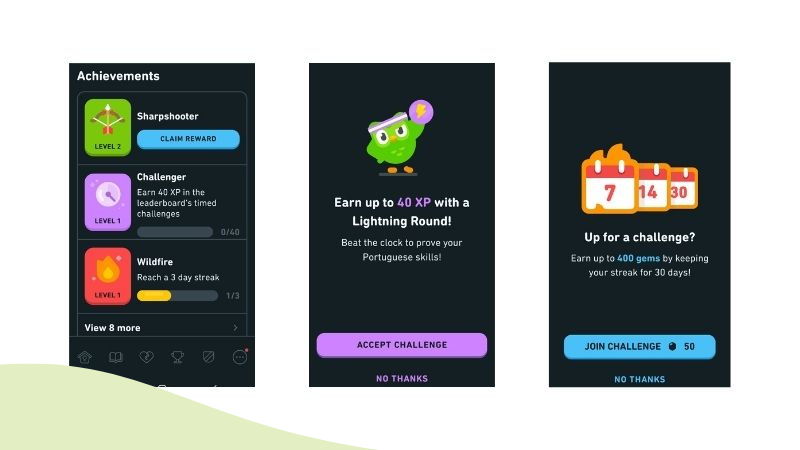
A Solid Motivation System Through Lingots, Crowns, And Streaks
What’s not to love with a fun challenge? Learning a language should make you excited and eager to learn more and more. Essentially, Duolingo makes motivation their mission, and with that goal comes the Lingots, Crowns, and Streaks.
You will earn Streaks when you finish daily while earning a Crown that you get after one topic you’ve accomplished. Lingots act as virtual points you earn when you level up, complete a skill, or get a 10-day streak. You can use these points in the rewards shop to redeem various perks, such as Monthly Streak Repair, to come back strong with your Streaks. You can also use Streak Freeze if you have an upcoming busy schedule for the whole day. Learners can also attempt to wager their lingots by enabling the Double or Nothing to maintain a seven-day streak.
You’ll Practice Speaking And Reading Simultaneously
As words are repeated back to you when you click on them, you’ll have this stimulus of repeating that word back. Speaking and reading are two of the main concepts of Duolingo in their daily lessons. While familiarizing yourself with the grammar structure, you’ll also practice your target language’s tone, accent, and pronunciation.
What’s New In Duolingo
- Duolingo Plus Is Now Super Duolingo
Super Duolingo is a quicker and more enjoyable way to use Duolingo. There is a progress tracker, Unlimited Hearts, an ad-free experience, monthly Streak Repair, Progress and Mastery Quizzes, and unlimited skill test-outs for all language levels.
The new appearance communicates a sense of energy and speed.
After the big update, you’ll see a significant improvement in Duolingo’s skill tree. Advanced learners will still enjoy the fun learning design while doing more demanding challenges.
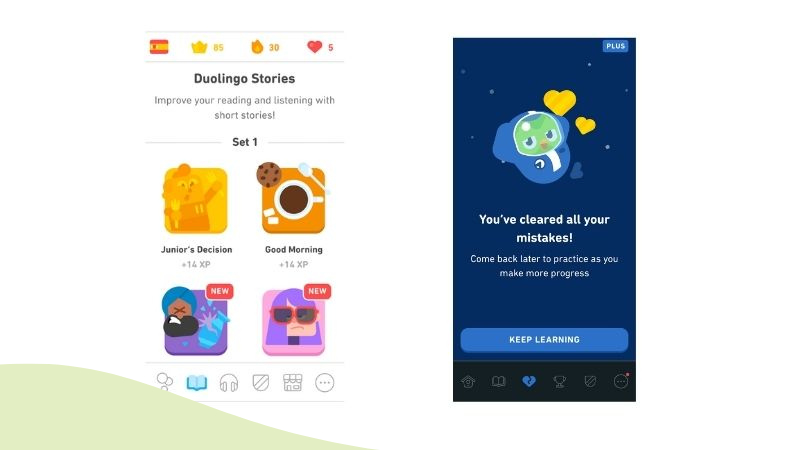
- Bite-sized Duolingo Stories
Duolingo Stories is one of the best new features for learning languages. In Duolingo Stories, you’ll hear short conversations and stories about different topics. These are audio lessons that will help your listening comprehension skills. Only Portuguese, Spanish, French, Italian, Japanese, and German are available in Duolingo Stories for English speakers. To unlock Duolingo Stories, you’ll need to get ten crowns either by repeating the same topic lesson or proceeding to the next set of vocabulary.
- The Duolingo Podcast
Another way to increase your listening exercises is to listen to the Duolingo Podcast. Even if it’s not part of the lessons, the website offers podcasts for real-life conversations about anything under the sun. Currently, only Spanish and French are the available languages to tune into.
Duolingo App: Stick To Free Or Buy The Duolingo Plus?
Duolingo Free
Online language learning should be extensive with speaking, reading, listening, and writing courses. Since many learners want all these skills in one app, Duolingo excels at this point. With Duolingo free, you’ll learn over thirty-eight languages and practice unlimited language skills building.
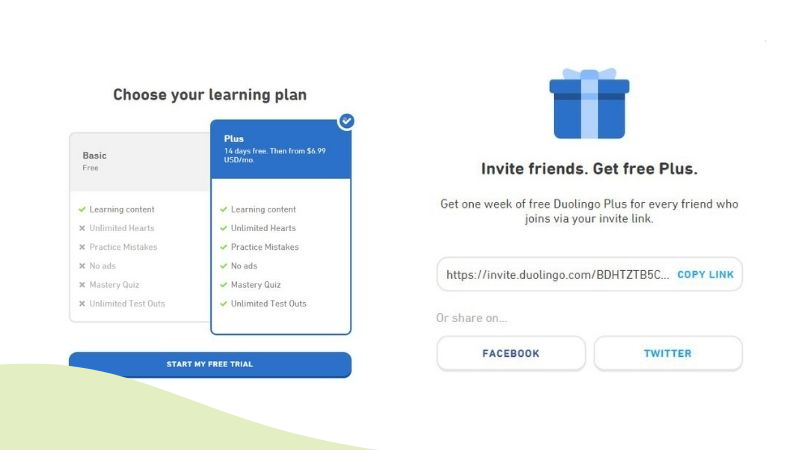
Duolingo Plus
Are you looking beyond the features of the free version of Duolingo? Try their premium subscription called Duolingo Plus. Duolingo Plus has a 14-day trial period and will charge you $6.99 monthly after the trial ends. For those 14 days, you’ll get additional features such as an ad-free version and unlimited hearts. Duolingo Plus allows you to correct answers for previous language courses you’ve finished.
You can also gain access to Duolingo Plus by inviting your friends to download and install Duolingo. Every friend who will join via your invite link gets a one-week free Duolingo Plus.
You’re also contributing to Duolingo’s mission for free education worldwide. That’s a great way to motivate yourself to keep your subscription while learning your target language.
Duolingo Review: Making Your Language Lessons Fun
I love testing language apps, and the free version of Duolingo is a great way to check if my learning style will differ. After signing up for an account, the Duolingo app takes me to which language I want to learn. Brazilian Portuguese is something that I have been contemplating for a few months now, so I chose that language. The app takes you to a placement test or the other option of going straight to the basics. After a few listening, speaking, reading, and writing exercises in the Basics 1 lesson, I immediately tried Duolingo Plus to see if it changed any of my learning methods. There are quite a few benefits and room for improvement on the app.
Not sure if Duolingo is the right app for you? Let’s explore the pros and cons of this free language learning resource in this Duolingo review.
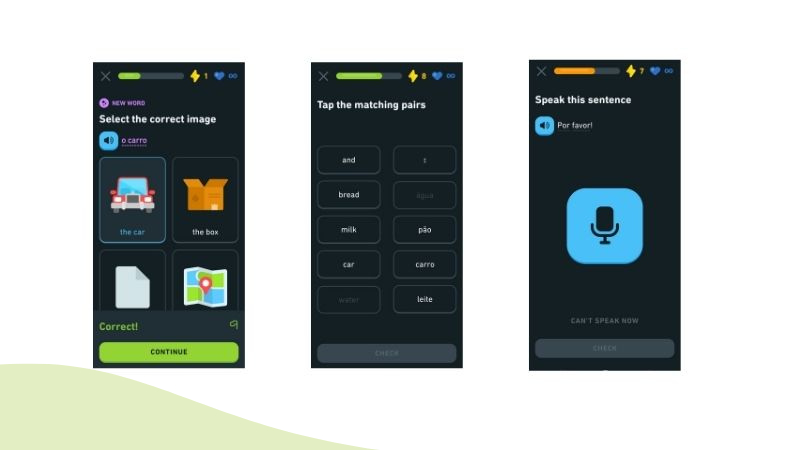
Benefits Of Duolingo
Quick And Easy Lessons
At least every one of us is busy with our personal tasks. Yet, language enthusiasts like you and I would like to learn new languages and become proficient despite the hectic schedule. You’ll only need 5-10 minutes of your time to go through each lesson.
Has a time tracker and statistics of your progress
You can edit your daily goal settings from Basic (1 XP per day) to Casual (10 XP) per day, or if you want to challenge yourself, set it to Intense (50 XP per day). It shows as a line graph on the desktop version and looks like a progress bar with a chest at the end on the app version.
Vocabulary Repetition Throughout The Lessons
Memory retention is vital for learners who need to reach their fluency like a native speaker. However, other language learning apps require you to return to your previous lesson by exiting the current one you’re learning. Not with Duolingo; it even gives you two bonus hard questions to check if you remember words you just learned in the previous topic.
It also repeats vocabulary you’ve made a mistake by repeating the same question before the lesson ends.
Challenges you to think about context clues with new words
While going through the course, you’ll often notice the words underlined. Once you press them, the English translation gives you its meaning. You’ll learn basic grammatical construction from the first few lessons. Duolingo also knows those language learning methods also need the learners to think critically. So, you’ll find yourself translating never-before-seen terms with some tips on that recent question.
In Which Ways Should Duolingo Improve?
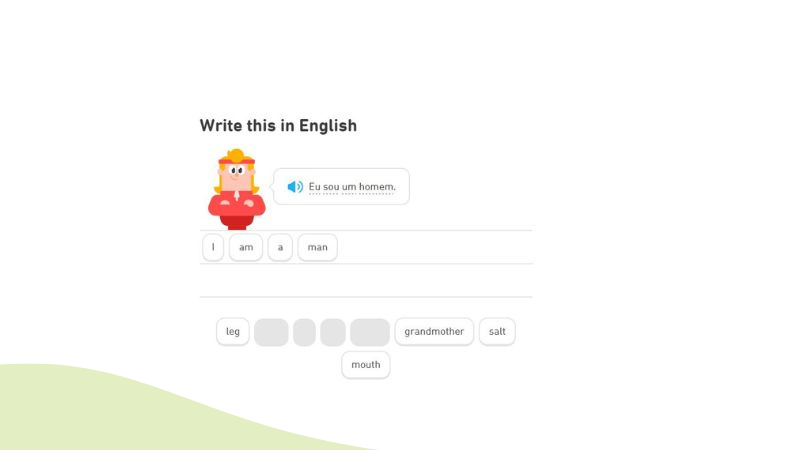
Random Vocabulary Appears Without Knowledge From Previous Lessons
Finding the meaning of a new vocabulary through context clues is a great challenge. But, many words are out of place and may not sound like natural conversations. Compared to its benefits, Duolingo needs to arrange how it introduces new words. If you’re familiar with learning vocabulary and then proceeding to quizzes, you’ll have frustrations.
several languages Are not accessible in Duolingo
Duolingo is still expanding its lessons and only has 38 languages as of this writing. If you’re looking for Khmer or Lithuanian, you may use alternatives for Duolingo instead. You can either use Ling or Drops, as they are effective and will teach you the right way of learning a new language.
Languages that are not available on Duolingo:
- Thai
- Tagalog
- Serbian
- Lithuanian
- Khmer
- Slovak
- Cantonese
- Croatian
- Urdu
Gamification Systems May Give A False Sense Of Achievement
You might notice that this language app focuses on games too much. It is not a great tool to use if you want to professionally teach languages to your friends or family. Serious language learning takes time to master. And having the tracker and streaks will make you feel like you need to be grinding your way to getting more XP (experience).
If you’re looking for language proficiency, you’ll have to find supplementary resources from tutors who speak the new language fluently online.
Not All Listening Exercises Have Native Speakers
In fact, their audio files sound more like an AI that talks to you. Though we understand that it will take lots of resources and money to hire many native speakers, it’s still a better option than mimicking robotic sounds.
A Few questions have missing Or Buggy words
Inevitably, I encountered a technical bug while reviewing this app. It may seem more of a developer issue, but language learners may find it irritating to see random keyboard characters instead of the vocabulary needed to match certain words. You’ll just have to answer all the previous vocabulary you know before choosing.
Speaking Exercises Is Not A Separate Feature
Duolingo does have speaking exercises through every new lesson you encounter. You can even turn this feature on or off. But, if you are looking for a separate page to help your daily pronunciation practice, it’s better to look for an alternative app. Audio lessons work because they force you to speak fluently like a native—natural linguistic acquisition.
How Good Is Duolingo As A Language Learning App?
Overall, Duolingo is a great start to grasping basic concepts in learning your target language. Since it’s a free app, many language learners prefer to use Duolingo rather than sign up for private tutors, which cost hundreds of dollars.
Duolingo’s edge against many competitors is its research team, which updates the app frequently. Through the behavior of its loyal users, it continues to adapt through customer reviews and their learning styles.
However, you might come to a point where you’ll feel that the Duolingo lessons are inadequate. Advanced learners combine Duolingo with other online resources such as listening to language podcasts, watching language lessons on YouTube, or attending an online class.
Want To Speak Fluently Like Native Speakers? Practice With The Ling App
As mentioned in this Duolingo app review, it is for people who love a reward system and point shop to make learning fun and fulfilling. But at times, you’ll feel more pressured to keep your streak high and get the bonus XP (experience) points for the challenge week.
However, learning a language is always a personal choice and should take time and full commitment. Having some pressure on your language learning will make learning a burden since we can’t help but be busy in our day-to-day personal lives.
If you’re really focused on fluency, try the Ling app! It has a speaking practice feature that prompts you to speak. If you’re missing the quizzes and fun flashcard-style games, the Ling app will improve your learning methods too.
It’s valuable for non-English native language learners to immerse themselves in a foreign language immediately. But, it would be great to start from the beginning as we’re not automatically experts in memorizing.
Want to learn Spanish, Korean, Thai, or other less-spoken languages worldwide? Start experiencing real lessons from native speakers through Ling! Download it now on the Play Store or App Store!
